In January, I wrote about my Professional Growth Plan (PGP) for this year, specifically my focus on Structured Word Inquiry in a Grade 2 classroom. Since writing that post, a lot has happened and a lot has not happened.
After my winter check-in with my Head of School, I was encouraged to go through the prototype protocol for this PGP. I was excited and inspired… but completely lost with where to begin. This is where my school’s Teaching and Learning Coordinator, Melissa Thompson, came in. Melissa worked with me to set up an action plan to guide me through the prototyping protocol. This included, but is not limited to, creating the description of my project, identifying success criteria, gathering data, comparing results, challenging assumptions, and of course, actually creating the lessons to teach! Since our initial meeting, we have been meeting monthly for check-ins and brainstorming. In our most recent check-in, I did share that things have been moving along slower than I originally would have liked. With life, a global pandemic, and HyFlex Teaching, I have decided to be forgiving with myself and do what I can this year, with the plan to continue this project next year. (Now is a great time to check out Confession #3 and remind yourself that it is ok to slow down if needed.)
So what does this all look like in a Grade 2 classroom?
From my first post about this PGP…
“While I am not prepared to identify 3 main spelling rules at this time…. What I know for certain is that I will launch SWI in my classroom with a deep dive into investigating Prefixes, Base Words, and Suffixes.”
…and that is exactly what I did. We looked at a few different words to start looking prefixes and suffixes.
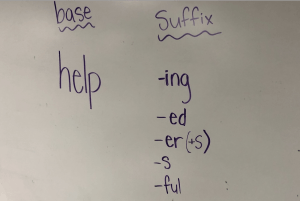
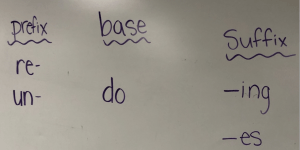
From there, all of the Grade 2 students became Prefix/Suffix Investigators! Students were asked to find words with prefixes or suffixes during quiet reading time and add them to the digital anchor chart I created on Jamboard.
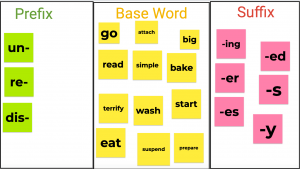
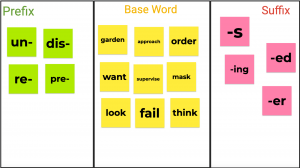
Once my students showed an understanding of prefixes, suffixes, and base words, we dove right in with one of my favourite lessons from our Structured Word Inquiry workshop last year with our school’s Director of Special Education, Sharon Reichstein.
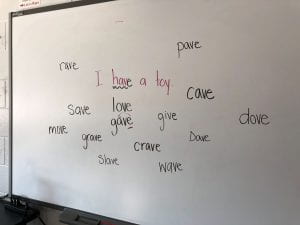
Looking at my students journals, I was noticing a common pattern with the word have. Many students were spelling it as hav. A common reading/writing strategy that primary students are taught is adding a “magic e” to the end of a word so the vowel can say its name, for example, in the word like. However, by teaching our students that, they miss all of the other reasons why we have the single silent <e>, for example, putting a single silent <e> at the end of the word have because no word in the English language ends with a <v>.
This led one of my students to ask about the word move. “I understand why we have the single silent <e> at the end of move, but why don’t we spell it like moove. We know that a double <o> makes the sound /oo/, so why don’t we spell it that way?”
…silence (from me).
My students were very excited to learn that I definitely do not have all the answers. That was when we all made a promise (myself included) to become word detectives and work together to learn as much as we can about Structured Word Inquiry.
We added the question about the word move to our “Next Steps in SWI” list, along with other questions about the different graphemes that make the long /u/ sound.
While we have not uncovered much yet, I am proud of the investigative questions my students have asked thus far. I will continue to use their investigations to guide future SWI lessons, along with the patterns in their spelling errors. In the coming weeks, we will investigate the long /u/ sound, as well as investigate why and when we drop the single silent <e> when adding suffix -ing, for example, making rather than makeing.
As always, if you have any guidance or resources for me to check out while I continue along this journey into Structured Word Inquiry, please share them in the comments!
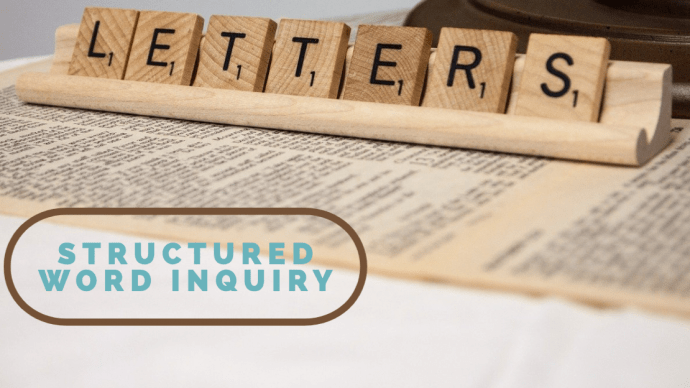
Lianna,
Wish you could see my smile as I read your post! You gave your students the greatest gift by showing them you don’t have all the answers, and that’s ok!
I loved the few lessons we did Sharon on SWI and the ones I started with my own students too. Those aha moments were so liberating for me as an adult, I can only imagine how exciting and cool it is for your students to make discoveries with you! I’m so excited for you to continue with this prototype so you can help the rest of us learn what works and what doesn’t when teaching this to students.
Hi Lianna,
Thanks for writing about your decision to help your students study the written word scientifically. I really enjoyed being able to watch you foster wonder and curiosity in your students as you helped them create good explanations for why words are spelled as they are.
It’s such a classical way to teach.
So rich.
So respectful.
So powerful.
I appreciated your student’s great question about the in . Why DO we use rather than to spell ?
Inquiring minds want to know, right?
They’re hungry for good explanations.
I love how the framework of SWI, the 4 questions of SWI, helps us create them.
As you probably already know, one of the tools recommended by many practitioners who use SWI (alone or in a learning community) is Doug Harper’s Online Etymology Dictionary, a wondrous resource for free information about the history of words — information that helps us think critically about their spelling. Perhaps is could help your students answer their questions?
What is the history of ? What is its story? Does it have any etymological relatives (question #3 of SWI)? I wonder if the process of answering these questions would help your students develop their understanding of that particular spelling and of the system itself. https://www.etymonline.com/search?q=move
http://files.realspellers.org/PetesFolder/resources/4_questions_of_SWI_Nov_17_2017_Bowers.pdf
I hope you’ll let us know.
Best regards and best wish to you and your students,
Stephanie Ruston
@Spell2Read
Hi Lianna, I too am new to SWI and have loved reading your blog post and I do have a question for you. This lady, Sharon that you speak of seems to have done a fantastic workshop with you on your favourite lesson, could you share it with us? It’d be so greatly appreciated. Oh yes, and if you haven’t already, the website wordtorque has wonderful ideas on SWI too.
Thank you
Lisa
Hi Lisa,
Thank you so much for reading my post and taking the time to comment. Sharon (a colleague from my school) does not have a public presentation to share with you unfortunately. It’s been through more informal PD sessions that she runs for our faculty. Thank you for sharing the website! I am finding a lot great SWI information on facebook as well in the “Learning How Words Work with Structured Word Inquiry ( SWI )” group. I am also always open to connecting via e-mail or video call if you’d ever be interested in chatting about more SWI specifics!
Lianna